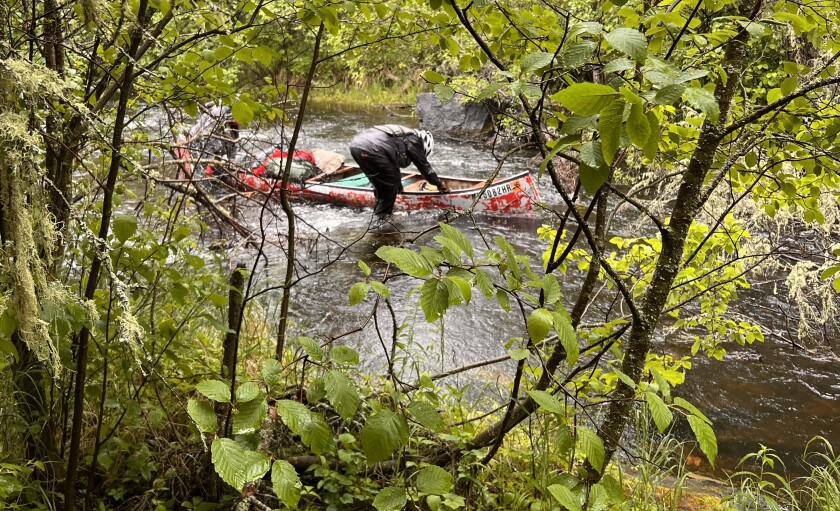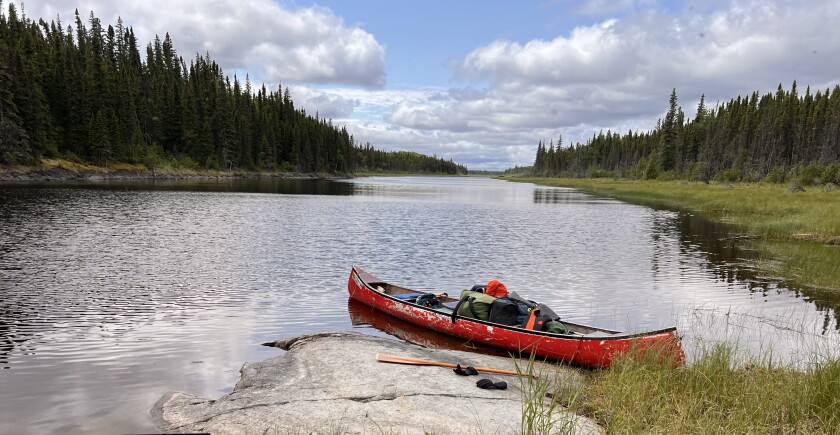Deb White of Rosemount, Minnesota; Deb Knutson of Owatonna, Minnesota; and Anne Sherve-Ose, a Jamestown, North Dakota, native who now lives in Williams, Iowa, recently attempted to complete the third leg of a canoe trip to Hudson Bay. After paddling from Lake Traverse and down the Red River through Grand Forks to the Canadian border in 2022, the trio in 2023 paddled out of the Red River and up the eastern shore of massive Lake Winnipeg to Norway House, Manitoba. They resumed their trek in late June, only to have the trip cut short after capsizing in a set of rapids on the Hayes River.
“It was violent,” said White, who shared this first-person account of their brush with disaster with the Herald.
ADVERTISEMENT
NORTHERN MANITOBA, Canada – This canoe trip was different. Everything was different, even though we had been canoeing together since 2004. We had always had a Plan B, and we had never really needed it.
OK, I lied. One time, the canoe blew away at night, and we were stranded on a flooded peninsula, but a rescuer was just downstream. We never found the canoe, but we were safe.
This year, we were headed into the wild on remote rivers of northern Manitoba. Starting from Norway House in Manitoba, a Cree First Nation Reserve, we planned to paddle 55 sets of rapids on the Hayes River. Our goal was to arrive at York Factory on Hudson Bay and then on to Churchill, Manitoba. The whole route was nearly 300 miles. Unfortunately, I was paralyzed by the thought of bears, but that turned out to be the least of our worries. We never saw a bear!

The three of us – Anne Sherve-Ose, Deb Knutson, and myself – are now officially all septuagenarians (over 70), but we felt confident that we were prepared, especially because Anne is a true leader who knows the ins and outs of river travel and had studied the route carefully. We had paddled the whole Mississippi River together, the whole Red River of the North and the full length of Lake Winnipeg. Let’s pack the canoe and carry on!
But it did not go as planned; there were rapids, portages, wind and cold. We also had a time limit: Our trip was scheduled to end July 18 with a boat pickup at York Factory. If we were late, we would miss our connection to Churchill.
Joys of paddling
Leaving Norway House on a beautiful June morning reminded us of the joys of paddling and the amazing benefits of nature. Clear water, dramatic clouds, granite cliffs and wonderful forests. Sandhill cranes danced across the reeds, river otters greeted us as we skimmed by, a moose wandered on the shore and the white-throated sparrows followed us everywhere.
ADVERTISEMENT

We began to feel the rhythm of the paddle and the strength of wind and current. We started on the Nelson River and then headed down the Echimamish River through gorgeous lakes like Hairy Lake, Windy Lake, Logan Lake, Max Lake and Oxford Lake, among others. The granite walls were impressive, the beaver dams prolific and the two major portages were daunting.
Suddenly, we arrived at (2 kilometers). I had been dreading this portage, since my upper body strength is not very good. But at least we were gifted with an early start and good weather. I kept reminding myself that teams of young men had managed to get large wooden York boats across this long, buggy stretch. They would roll the boat over multiple logs laid across the trail. It took them 50 hours, but it only took us eight!

We took three trips total to get across, but we did it in stages. Carry the Duluth Pack a quarter mile and then go back for something else. That way, we got several short rest periods between the hard parts. Independent Anne took off with her 70-pound pack on her slender frame; such a toughie! The Debs were not toughies; it took us two minutes just to hoist the pack sto our backs. The other Deb wanted me to guide her along the path, which is laughable because my eyes are so bad. The path was OK, but had a number of downed trees and branches grabbing at our gear. We had bug nets on our heads, but the gnats were smart, and we came away bloody from the bites.
Just when I was thinking this wasn’t so bad, we encountered a beaver dam that created a 50-yard lake/mud hole right in the center of the path. The trees were so thick we couldn’t bushwhack around it. As the mud sucked at our boots, the bugs sucked at our blood. Deb K. and Anne both fell into a deep hole of sludge up to their waists. For me, comic relief! I kept wondering how we were going to portage the canoe through that mess.
After our first trip across the Robinson Portage, I grabbed my handsaw and cleared the path for the second trip. I felt pretty tough! We were crushing it! But then Anne and I began pulling on the same downed birch tree, and my section broke off. The remainder swung back like a baseball bat, hitting Anne right across the forehead. She had a knob on her head for the rest of the week. I think of it as karma for the time she threw a paddle to me, and I had a black eye for a week. We are even! Meanwhile we had lost track of the other Deb, and we saw that she was so tired that she had returned to the start of the portage without leaving her pack off at the other end.
Oh, boy. …

ADVERTISEMENT
Wave of relief
Carrying the canoe was horrible for me. We tried to lift it up and carry the 80-pounder as a trio, but we really struggled just to hoist it up. Once we finally got it over our heads, I was gasping for air and could go only about 50 steps. Sheer determination helped us, and I felt such admiration for Anne because she just kept trucking. It was such a wave of relief when we finished Robinson … little did I know of the portages to come.

The forest changed and in the next miles we saw many beaver dams and lodges. Dragging the canoe over the high piles of sticks was getting easier as we gained new strength, and at night, we heard the beavers slap their tails. In addition, we saw eagles, loons, hawks and surprisingly a few trashed trapper cabins that dotted the shoreline.

We traveled for 10 days without seeing a soul. We enjoyed eating a few walleyes, cooked dehydrated food and downed lots of oatmeal at 5 a.m. I could feel my muscles strengthen and my body adapt to the long days. We had wind and some rainy days, but we were so blessed with fairly good weather. When we finally reached Oxford House, we were ready to enjoy some junk food and visit the Cree of this First Nation. This village of about 3,000 people is the last civilization on the Hayes River. For the next 228 miles, we would be truly alone.
But the next day broke us.
Disaster strikes
We had already done nine sets of rapids, and the next two happened without incident. Then we hit a rock in rapids No. 12 and tumbled over. The spray skirt kept all of our gear in, but it also kept me in. I forgot that I needed to release the cord, so I stayed underwater for a bit. I never got scared because it was over so fast. Anne and Deb had floated farther down the river, so I grabbed the canoe and my paddle and swam my way to shore.
Immediately, I saw that our trip was over; Anne reported that she had a broken rib, and she had lost the Garmin tracker from the carabiner on her lifejacket. So we couldn’t call for a rescue … we had to rescue ourselves.
Deb K. had floated downstream and managed to lose her shoes. When she climbed out, we set up the tent, and Anne and Deb climbed inside to warm Anne up. She has a condition called Raynaud’s, which reduces blood flow to the extremities and causes her hands and feet to turn into ice blocks. I boiled water to put in her Nalgene bottle. I have failed to mention that it rained the whole day so we were completely soaked, as were our packs, with no hope of drying. They probably weighed an extra 20 pounds each.
ADVERTISEMENT
Three hours later, Anne was warm but she was really hurting, and I realized we had to get moving and return to Oxford House. Anne bushwhacked through the dense woods as Deb K. and I tried to drag the loaded canoe up a sidestream where the current wasn’t as strong. The footing was very slippery. Deb K. just couldn’t keep up with the rocks, making her fall and tarry. She joined Anne on the shore, and we met above the rapids.
While paddling upstream a stretch to the next set of rapids, I learned how to start the Jetboil stove between my feet to heat up more water for Anne. I had to smile at how crazy the situation was, and I even told Anne that I was kind of enjoying this ordeal because we could see that we were making progress. It was now 3 p.m., and we had been at it for six hours. After two more sets of rapids, we found ourselves back at the Cree Nation of Oxford House.
Seeking help
By now, it was 9 p.m. and getting dark. We had been soaking wet for 12 hours and had nothing to eat or drink. I apprehensively approached a house to seek help, and to my amazement the man who came out was the same person who had been in line before me at the grocery store the day before. More importantly, he was on the tribal council, had a truck and was willing to take us to the nursing station.

Anne did have a broken rib, hypothermia and severe dehydration. After delivering us to the medical facility, Anthony and his grandson brought our gear up to the tribal office. They provided us with two nights’ shelter and reaffirmed that there are good people everywhere. Luckily, a day later, three spots opened up on Perimeter Air, which brought us back to Winnipeg. By Saturday, July 6, we were back in Minneapolis with some family and friends. Not sure if they were relieved or just peeved.
It’s been a few weeks since we returned to our homes and tried to get back to normalcy. There is a gnawing feeling of a trip unfinished, a goal not met and an ache in our hearts to still be in the wilderness. Deb Knutson will not be returning to this remote land, but Anne and I are tinkering with the idea that we can finish this, that we can do it better.
I still see the Hayes River in my dreams, and it is not a nightmare. It is a sweet dream of challenging ourselves to view what is around the next bend.
ADVERTISEMENT












